The impact of ocean acidification on gastropod shell dissolution and microstructure
IF 3.3
2区 地球科学
Q2 ENVIRONMENTAL SCIENCES
引用次数: 0
Abstract
Global seawater pH is projected to decrease by 0.3–0.5 units on average by the end of this century, which is considered detrimental to the shells of marine calcareous organisms. However, there is limited understanding of how ocean acidification affects the morphology and structure of these shells, as well as the underlying mechanisms. This study examines the shell growth, surface erosion, and microstructural changes of the marine gastropod Lunella coronata granulata after 85 days of exposure to varying pH (8.1–7.1). The results reveal that at pH ≤ 7.5, shell growth is notably inhibited, with pronounced dissolution hole formation on the inner surface. At pH 7.1, shell surface erosion becomes more pronounced, accompanied by extensive peeling of the shell periostracum. These changes—dissolution hole formation and periostracum peeling—are critical indicators of gastropod shell response to ocean acidification and can serve as biological indicators reflecting current and past ocean acidification. Additionally, our study shows a clear negative correlation between shell dissolution and pH, providing new bio-proxy for indicating the pH changes.
海洋酸化对腹足类动物壳溶解和微观结构的影响
预计到本世纪末,全球海水pH值将平均下降0.3-0.5 单位,这被认为对海洋钙质生物的外壳有害。然而,人们对海洋酸化如何影响这些贝壳的形态和结构以及潜在机制的了解有限。本研究研究了海洋腹足动物Lunella coronata granulata在不同pH值(8.1-7.1)下暴露85天后的壳生长、表面侵蚀和微观结构变化。结果表明,当pH≤ 7.5时,壳的生长受到明显抑制,内表面形成明显的溶解孔;当pH值为7.1时,贝壳表面侵蚀更为明显,并伴有广泛的贝壳骨膜剥落。这些变化——溶孔形成和膜膜剥离——是腹足类贝壳对海洋酸化响应的重要指标,可以作为反映当前和过去海洋酸化的生物学指标。此外,我们的研究表明壳溶解与pH之间存在明显的负相关关系,为指示pH变化提供了新的生物代理。
本文章由计算机程序翻译,如有差异,请以英文原文为准。
求助全文
约1分钟内获得全文
求助全文
来源期刊

Anthropocene
Earth and Planetary Sciences-Earth and Planetary Sciences (miscellaneous)
CiteScore
6.30
自引率
0.00%
发文量
27
审稿时长
102 days
期刊介绍:
Anthropocene is an interdisciplinary journal that publishes peer-reviewed works addressing the nature, scale, and extent of interactions that people have with Earth processes and systems. The scope of the journal includes the significance of human activities in altering Earth’s landscapes, oceans, the atmosphere, cryosphere, and ecosystems over a range of time and space scales - from global phenomena over geologic eras to single isolated events - including the linkages, couplings, and feedbacks among physical, chemical, and biological components of Earth systems. The journal also addresses how such alterations can have profound effects on, and implications for, human society. As the scale and pace of human interactions with Earth systems have intensified in recent decades, understanding human-induced alterations in the past and present is critical to our ability to anticipate, mitigate, and adapt to changes in the future. The journal aims to provide a venue to focus research findings, discussions, and debates toward advancing predictive understanding of human interactions with Earth systems - one of the grand challenges of our time.
 求助内容:
求助内容: 应助结果提醒方式:
应助结果提醒方式:


